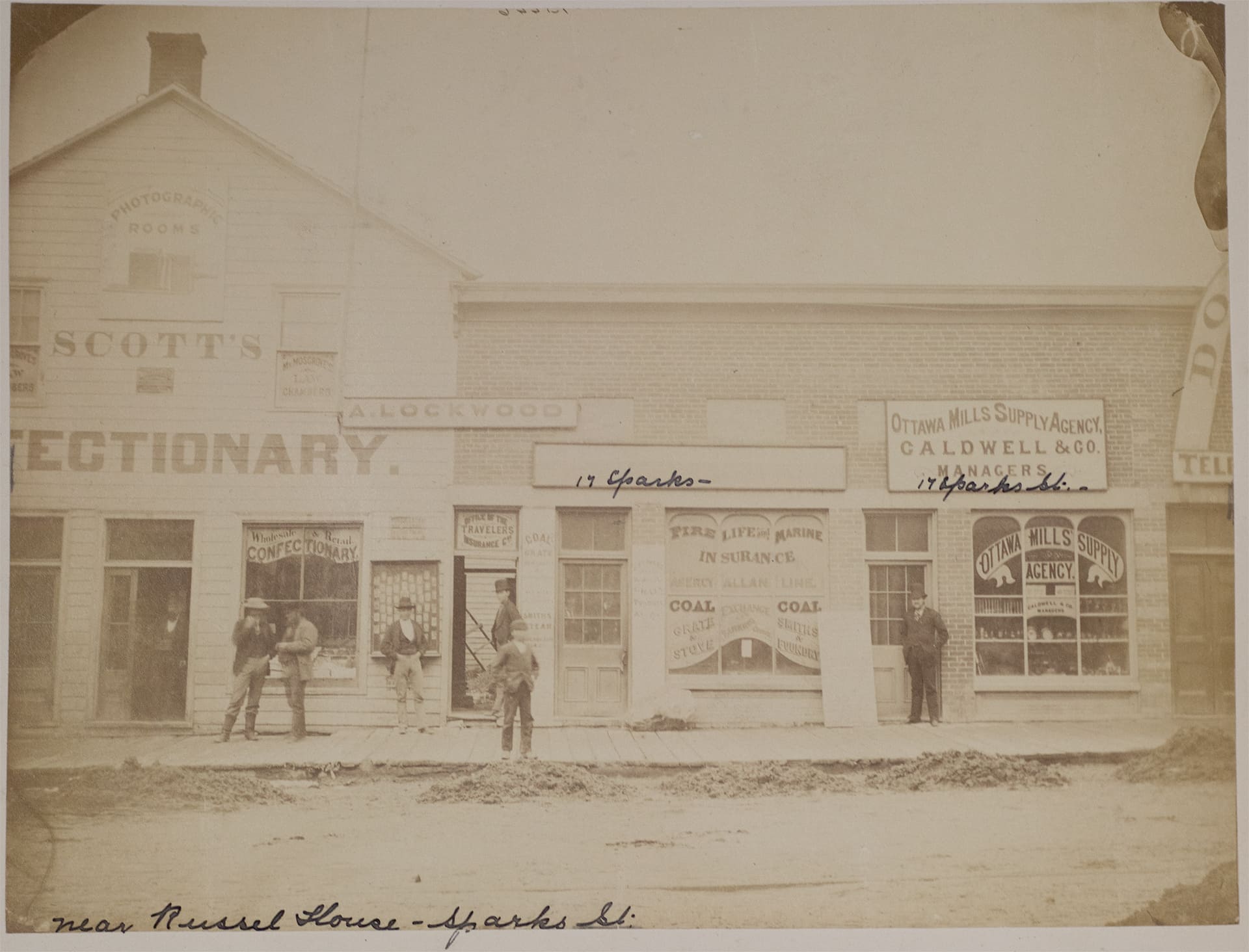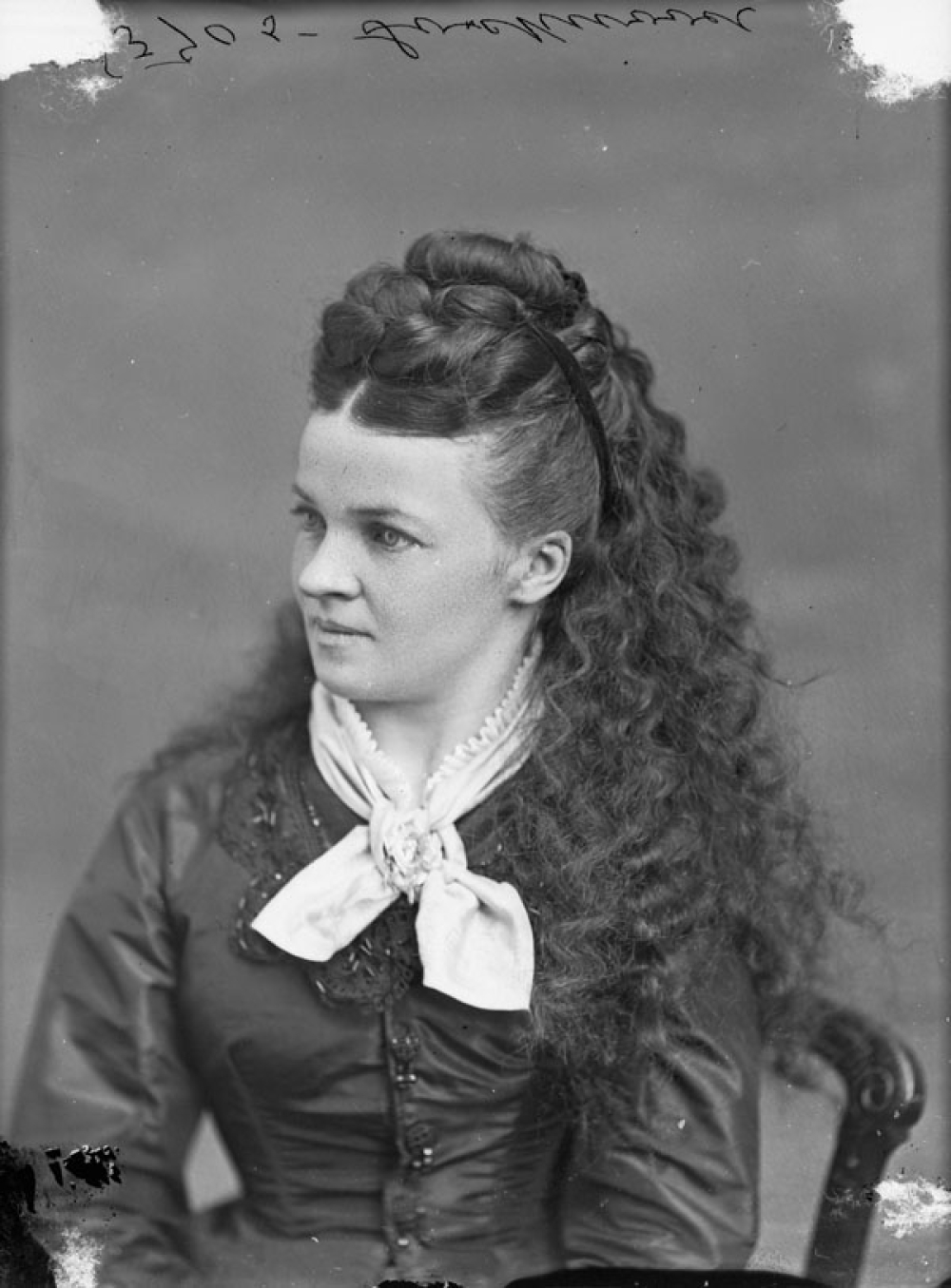Born in Kemptville, Ontario (Canada West) on October 6, 1842 to Elizabeth “Melinda” Pierce and Joseph Lockwood, Alvira Lockwood, the eldest of eight children, was one of Ottawa’s earliest photographers, as well as the city’s first professional female photographer, and likely, its youngest. Her vast catalogue has been all but lost over the years – her negatives destroyed by fire or discarded, her photographs rare and mostly in private holdings, and her pioneering work largely unknown outside of local photographic circles. However, her impact on the development of photography, and of the art scene in general in Ottawa was undeniable.
From a young age, Alvira began her informal education in the photographic process by assisting her father Joseph, a traveling daguerreotype artist originally from Madrid, New York. Throughout the 1840s, Joseph operated via a horse-drawn portable photography saloon in Carleton and Lanark Counties, as well as in upper New York State and western Quebec with partner George Martin of Montréal.[[1]] In 1851, after several itinerant years, the Lockwood family settled in Bytown and built a home and studio on Sparks Street. Joseph’s studio, Lockwood’s Daguerrean Gallery, advertised daguerreotypes, melainotypes, and ambrotypes, and dealt in photographic supplies.[[2]] The home was said to have been quite conspicuous, being the first building at the western end of Sappers Bridge.[[3]] Unfortunately, by early 1859 the landowner, Sir Henry Egan, notified Joseph of his intention to reclaim the land and the home was pulled down. Lockwood Studio then moved into a space over Scott’s Confectionary on the southwest corner of Sparks and Elgin Streets.[[4]]
Sadly, Joseph Lockwood died of consumption in 1859, and ownership of the business passed to Melinda. Alvira, who was just 12 years old at the time of her father’s death, was ever-present in the studio and knew the business and the photographic process well. She later stated, “from the time I was seven years old I had always been around the studio” and, “at fifteen I was a full-fledged photographer.”[[5]]
 Figure 2 Notman Studios, William James Topley (attrib.), Sparks Street Storefront (detail), c.1870, City of Ottawa Archives, MG597.
Figure 2 Notman Studios, William James Topley (attrib.), Sparks Street Storefront (detail), c.1870, City of Ottawa Archives, MG597.
By 1863 Alvira began operating the studio under her own name. Her studio at 15 Sparks Street (renumbered 44 Sparks Street after 1875) was adorned with a simple sign that read “A. Lockwood,” with a larger sign featuring an image of an old daguerreotype camera (a nod to her father’s earlier work) and reading “Photographic Rooms” at the building’s gable.[[6]] Alvira’s photographic work focused almost exclusively on portraiture. By the later part of the 1860s she was producing mostly carte-de-visite prints and cabinet cards, which were more accessible to the burgeoning middle class than earlier cased photographs.
In 1870, Alvira had built a house on Rideau Street (between Nelson and Friel Streets), where she lived with her mother, and where she also maintained both an office of sorts and her amateur painting studio.[[7]] On March 19, 1872, the home was destroyed by fire. In the aftermath, the Ottawa Journal reported that many citizens had “joined in making up a purse… as a tribute of their regard… to a most deserving lady on the occasion of [Alvira’s] recent trouble.”[[8]] Following the fire, Alvira continued her work in Ottawa, operating on Sparks Street while living in the up-and-coming Sandy Hill neighbourhood.[[9]]
Alvira closed her studio in 1883 to pursue an education in painting, a long-enduring passion which she had set aside in order to focus on the family business. She first relocated to New York, and then to Paris, where, according to a later interview in the Ottawa Citizen, she spent a further five years “under the great teachers of the eighties.”[[10]] Alvira returned to Ottawa in 1891 and opened a new studio in her home at 386 Rideau Street where she devoted considerable time to painting. For many years Alvira “taught oil painting, painting on china, charcoal work, burnt wood work, water colors, etc.” out of her home studio, which was judiciously hung with her own works.[[11]] She entered, and often won, competitions at local fairs, submitting works of embroidery, painting, charcoal, and more.[[12]] Later in life, Alvira continued her artistic endeavours, taking woodworking classes and remaining active within the community. She was a member of the Ottawa Horticultural Society and the Canadian Red Cross. An article in the Ottawa Citizen described an eighty-year-old Alvira as “not a bit” old fashioned: “She lives vigerously [sic] in the present and is right up to date.[[13]]
Alvira Lockwood died at the Perley Home for Incurables on April 5, 1925, at the age of 82. She had been suffering from hemiplegia (paralysis) for several months, eventually dying of heart failure. Her funeral was attended by her brother Joseph, as well as her sister Eliza Lockwood, Mrs. B. Billings, and Mrs. Jennie Russell Simpson, then-member of the Women’s Canadian Historical Society of Ottawa, among many others.[[14]] A handful of her portraits remain in museums and private collections, while an unsubstantiated portrait of the artist herself exists within the holdings of Library and Archives Canada. The Bytown Museum currently holds a collection of fifteen of her portraits. Alvira was pioneer in Ottawa’s burgeoning photography scene, Ottawa’s first professional female photographer and a beloved figure in the city’s artistic community.
Grant Vogl is the Senior Manager, Collections and Exhibitions, at the Bytown Museum. Grant has worked in the heritage sector since 2007, holding various positions relating to: collections management, curatorial research, and exhibition development. With the Bytown Museum since 2010, Grant has curated sixteen temporary exhibitions, co-curated twenty-two community-based exhibitions, and undertaken major updates throughout the Museum's permanent gallery. In addition, he has led the Museum's digital initiatives, including social media, virtual tours, video guided tour and vignette series, digitization, and more. Grant has contributed to numerous periodicals, publications, books, conferences, research papers, and partner exhibitions, and delivers regular public lectures throughout the heritage community. In 2022 Grant spearheaded the OMA award-winning "Permanent Gallery Renewal Project" in close collaboration in the Algonquin community, presenting the topic at the 2023 CMA conference.
Notes
[[1]] Curtis Gates, Our County and Its People: A Memorial Record of St. Lawrence County (New York: D. Mason, 1894), 88-89.
[[2]] Clint Hryhoijiw, “Clint’s Curio Corner,” Email Supplement to Photographic Canadiana for Volumes 10-12, January 2013, 7, https://phsc.ca/camera/wp-content/uploads/2013/01/PHSC-E-Mail-V12-10rev.pdf; Gates, Curtis, Our County and Its People, 88-89;“Along Sparks Street,” The Ottawa Citizen, November 9, 1907, 19, Newspapers.com.
[[4]] “View of the Southwest Corner of Sparks and Elgin Streets 55 Years Ago,” The Ottawa Citizen, June 20, 1925, 26, Newspapers.com.
[[6]] Notman Studios/William J. Topley, “Sparks Street storefront,” ca.1870s, City of Ottawa Archives, MG597.
[[7]] Cherrier & Kirwin's Ottawa Directory For1872-1873, (Ottawa: Cherrier & Kirwin 1872), 89,156, https://vitacollections.ca/ottawalibrary/3566634/page/3?n=.
[[8]] “Destructive Fire,” The Ottawa Daily Citizen, March 20, 1872, 3, Newspapers.com; “A Handsome Testimonial,” The Ottawa Daily Citizen, March 21, 1872, 3, Newspapers.com.







